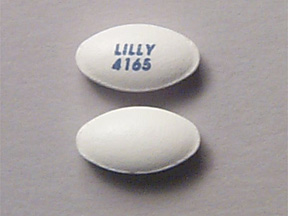Evista Side Effects
Generic name: raloxifene
Medically reviewed by Drugs.com. Last updated on Sep 8, 2023.
Note: This document provides detailed information about Evista Side Effects associated with raloxifene. Some dosage forms listed on this page may not apply specifically to the brand name Evista.
Applies to raloxifene: oral tablet.
Important warnings
This medicine can cause some serious health issues
Oral route (tablet)
Increased risk of deep vein thrombosis and pulmonary embolism have been reported.
Women with active or past history of venous thromboembolism should not take raloxifene hydrochloride.
Increased risk of death due to stroke occurred in a trial in postmenopausal women with documented coronary heart disease or at increased risk for major coronary events.
Consider risk-benefit balance in women at risk for stroke.
Serious side effects of Evista
Along with its needed effects, raloxifene (the active ingredient contained in Evista) may cause some unwanted effects. Although not all of these side effects may occur, if they do occur they may need medical attention.
Stop taking raloxifene and get emergency help immediately if any of the following effects occur:
Rare
- coughing blood
- headache or migraine headache
- loss of or change in speech, coordination, or vision
- pain or numbness in chest, arm, or leg
- shortness of breath (unexplained)
Check with your doctor as soon as possible if any of the following side effects occur while taking raloxifene:
More common
- bloody or cloudy urine
- chest pain
- difficult, burning, or painful urination
- fever
- frequent urge to urinate
- infection, including body aches or pain, congestion in throat, cough, dryness or soreness of throat, runny nose, and loss of voice
- leg cramping
- skin rash
- swelling of hands, ankles, or feet
- vaginal itching
Less common
- abdominal pain (severe)
- aching body pains
- congestion in lungs
- decreased vision or other changes in vision
- diarrhea
- difficulty in breathing
- hoarseness
- loss of appetite
- nausea
- trouble in swallowing
- weakness
Other side effects of Evista
Some side effects of raloxifene may occur that usually do not need medical attention. These side effects may go away during treatment as your body adjusts to the medicine. Also, your health care professional may be able to tell you about ways to prevent or reduce some of these side effects.
Check with your health care professional if any of the following side effects continue or are bothersome or if you have any questions about them:
More common
- hot flashes, including sudden sweating and feelings of warmth (especially common during the first 6 months of treatment)
- increased white vaginal discharge
- joint or muscle pain
- mental depression
- problems of stomach or intestines, including passing of gas, upset stomach, or vomiting
- swollen joints
- trouble in sleeping
- weight gain (unexplained)
For healthcare professionals
Applies to raloxifene: oral tablet.
Cardiovascular
- Very common (10% or more): Hot flashes/hot flushes/vasodilation (28.7%), increased blood pressure
- Common (1% to 10%): Varicose vein, venous thromboembolism (VTE)
- Postmarketing reports: Death related to VTE[Ref]
Other
- Very common (10% or more): Flu syndrome (16.2%), infection (15.1%), peripheral edema (14.1%)
- Common (1% to 10%): Chest pain, fever[Ref]
Musculoskeletal
- Very common (10% or more): Arthralgia (15.5%), muscle spasms/leg cramps (12.1%)
- Common (1% to 10%): Myalgia, arthritis, tendon disorder[Ref]
Respiratory
- Very common (10% or more): Sinusitis (10.3%), rhinitis (10.2%)
- Common (1% to 10%): Bronchitis, pharyngitis, increased cough, pneumonia, laryngitis[Ref]
Dermatologic
- Common (1% to 10%): Rash, sweating[Ref]
Endocrine
- Common (1% to 10%): Breast pain/tenderness/enlargement[Ref]
Gastrointestinal
- Common (1% to 10%): Nausea, diarrhea, dyspepsia, vomiting, flatulence, gastrointestinal disorder, gastroenteritis, abdominal pain[Ref]
Genitourinary
- Common (1% to 10%): Vaginitis, urinary tract infection, cystitis, leukorrhea, uterine disorder, vaginal bleeding, endometrial disorder, vaginal hemorrhage, urinary tract disorder[Ref]
Hepatic
- Common (1% to 10%): Cholelithiasis, cholecystectomy
- Frequency not reported: Slightly decreased platelet counts, moderate increases in AST and/or ALT[Ref]
Metabolic
- Common (1% to 10%): Weight gain[Ref]
Nervous system
- Common (1% to 10%): Headache/migraine, syncope, vertigo, neuralgia, hypesthesia, stroke, death related to stroke[Ref]
Ocular
- Common (1% to 10%): Conjunctivitis
- Postmarketing reports: Retinal vein occlusion[Ref]
Psychiatric
- Common (1% to 10%): Depression, insomnia[Ref]
Hematologic
- Uncommon (0.1% to 1%): Thrombocytopenia[Ref]
Oncologic
- Uncommon (0.1% to 1%): Benign endometrial polyps
- Frequency not reported: Endometrial cancer, ovarian cancer, endometrial atrophy[Ref]
References
1. Cerner Multum, Inc. "UK Summary of Product Characteristics."
2. Cerner Multum, Inc. "Australian Product Information."
3. (2016) "Product Information. Raloxifene (raloxifene)." Prasco Laboratories
Frequently asked questions
More about Evista (raloxifene)
- Check interactions
- Compare alternatives
- Pricing & coupons
- Reviews (12)
- Drug images
- Dosage information
- Patient tips
- During pregnancy
- Generic availability
- Drug class: hormones/antineoplastics
- En español
Patient resources
Professional resources
Related treatment guides
Further information
Evista side effects can vary depending on the individual. Always consult your healthcare provider to ensure the information displayed on this page applies to your personal circumstances.
Some side effects may not be reported. You may report them to the FDA.

